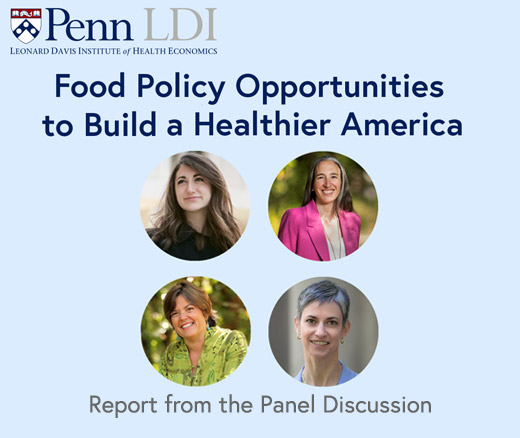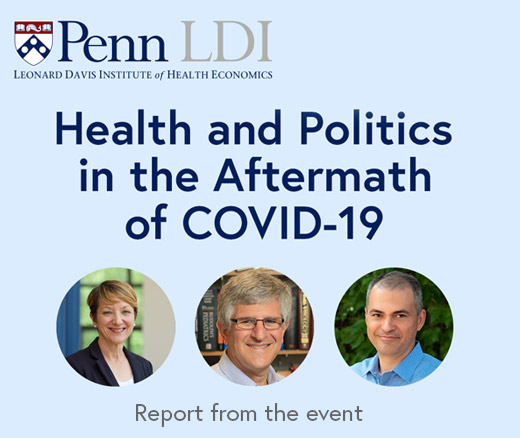
Contradictions That Confuse Federal Food Policies
Announcing Bold New Goals While Crippling the Infrastructure Needed to Achieve Them
Population Health
Blog Post
LGBTQ individuals consume tobacco products at much higher rates than their heterosexual counterparts—with certain populations, like sexual minority women and transgender individuals, reporting more than three times higher use of cigarettes than their cisheterosexual counterparts. This is no coincidence, said LDI Senior Fellow Andy Tan, PhD, MPH. The tobacco industry’s marketing has “systematically targeted” the LGBTQ community for decades, said Tan, principal Investigator of the Communication and Health Equity Lab at the University of Pennsylvania’s Annenberg School for Communication.
He cited Project Subculture Urban Marketing, or Project SCUM as one example of the “highly successful and manipulative strategies” the tobacco industry directed at the LGBTQ community starting in the 1990s.
“The acronym alone is profoundly disturbing”, said LDI Senior Fellow and Professor of Law Eric Feldman, JD, PhD. Feldman called out the dubious methods of Project SCUM and other campaigns that placed advertisements in locations frequented by gay men and homeless individuals. Targeted ads played on language important to this community, including taglines mentioning “pride” or “the right to choose.”
Equating smoking with a movement towards liberation mirrored marketing tactics targeting women, where tobacco use was painted “as representing strength, independence, and power,” Feldman said. While it is difficult to quantify the impact of these campaigns, it is hypothesized that they are part of the puzzle explaining higher rates of tobacco use that are pervasive among sexual and gender minority groups.
Today, advertisements so blatantly targeting the LGBTQ community “would have been really obvious to pick up on and to shut down quickly,” Tan said. But that’s not to say that targeting has completely stopped.
Rather, marketing has shifted from targeting by demographics to targeting by psychographics, Tan said. With psychographics, the tobacco industry can tailor advertisements to interest groups, such as certain fashion or video game communities where LGBTQ individuals are more represented. This approach allows more granular advertising that still effectively targets LGBTQ individuals. Feldman concurred, hypothesizing that electronic cigarette companies “carefully crafted their advertising to the LGBTQ community.”
Government spending priorities have further complicated tobacco use in this community. Research funding for LGBTQ communities largely goes toward work on HIV, sexually transmitted infection testing, and HIV-preventing pre-exposure prophylaxis, Tan said. He noted that less than 3% (p. 9, fig. 6) of National Institutes of Health funding goes towards research on prevention and cessation of tobacco use. Feldman also pointed to delays in regulating noncombustible tobacco products, like e-cigarettes, and their uptake among youth as major hurdles in anti-smoking efforts.
How to address these factors is “the multimillion dollar question from the public health perspective,” Tan said.
His team is working on an campaign called Project RESIST testing the effectiveness of LGBTQ imagery and other “cultural tailoring” to change beliefs around tobacco use in a more focused way than generic antismoking messages. They are collaborating closely with stakeholders, including members of the Fenway Health Institute and LGBTQ youth advisors, to craft effective and respectful messaging that is representative of sexual and gender minorities.
“Visible health equity campaigns” are an essential first step to reduce smoking in higher-risk communities, according to Feldman. He also pointed to the importance of regulating advertising, a goal that Tan also endorses, calling for “regular, ongoing, rapid surveillance of the tobacco product marketplace.”
State and regional governments, particularly public health departments, can also play a role by regulating which tobacco products retailers can sell and where they can sell them, Tan suggested. Such regulation could “drastically reduce overall tobacco use,” particularly among younger people, he said.
Tan and Feldman highlighted the need for ongoing efforts such as these to counteract tobacco industry marketing and achieve health equity in tobacco use for sexual and gender minorities.
The study, “‘We’re Always an Afterthought'”- Designing Tobacco Control Campaigns for Dissemination With and to LGBTQ +—Serving Community Organizations: A Thematic Analysis,” was published on May 9, 2023 in Cancer Causes & Control. Authors include Shoba Ramanadhan, Meg Salvia, Elaine Hanby, Anna Revette, Madison Rivard, N. F. N. Scout, Julia Applegate, Bob Gordon, Ana Machado, Mitchell Lunn, Juno Obedin-Maliver, Jennifer Potter, Jarvis Chen & Andy Tan.

Announcing Bold New Goals While Crippling the Infrastructure Needed to Achieve Them

Promising New Evidence and What’s Next

From 1990 to 2019, Black Life Expectancy Rose Most in Major Metros and the Northeast—but Gains Stalled or Reversed in Rural Areas and the Midwest, Especially for Younger Adults

A Penn LDI Seminar Focuses on Why They’re Important for the Future

Former Philadelphia Health Commissioner Warns That Gutting the CDC, Undermining Vaccines, and Politicizing Science Will Leave the U.S. Dangerously Unprepared for the Next Pandemic

Rural Parents Had More Emergency Visits and Insurance Loss Than Urban Peers, an LDI Study Shows. Integrated Baby Visits Could Help All Parents Be Healthier